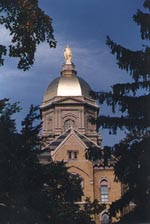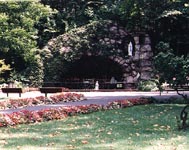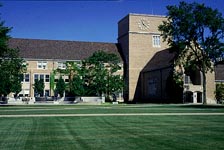Public Relations and Information | Athletic Department Directory | Athletic Director | Campus Leaders
Indicators of Excellence | Principles of Athletics | NCAA Regulations | Student-Athlete Handbook ![]()
This is Notre Dame
 |
| The golden-domed Main Building (Click for larger version) |
The University of Notre Dame’s institutional mission is to attain the highest standards of excellence in teaching, scholarship, and selected fields of research in a community of learning where truth is seen to be informed by belief and where, specifically, the Catholic faith and intellectual tradition are celebrated and lived.
Notre Dame’s founding can perhaps best be characterized as an outburst of missionary zeal. How else can one describe the action of Father Edward Sorin, the 28-year-old French priest of the Congregation of Holy Cross who, with $310 cash and three log buildings in various stages of disrepair in the middle of the northern Indiana frontier, had the temerity to christen his enterprise the University of Notre Dame du Lac? 
Notre Dame at its founding was a name in search of, or perhaps in anticipation of, a university. The wonder is not so much what the University has become more than a century and a half later, but that it survived at all in those early years of beginning almost literally from nothing. In his book, “The University of Notre Dame: A Portrait of Its History and Campus,” historian Thomas Schlereth of the American studies department has described the odds the University was up against:
“Only nine other Catholic colleges existed when Notre Dame was founded but that number had grown to 51 by 1861. Presently only seven of these antebellum institutions still exist. One historian estimates a mortality rate of approximately 80 percent among Notre Dame’s contemporary secular institutions. Yet Notre Dame survived…”
 |
| The Grotto (Click for larger version) |
The University’s survival of those early years is a tribute not only to the faith of Father Sorin, but also his pragmatism and wit. In the beginning, his institution’s only admissions requirement was the ability to pay-some payment, at least, and not necessarily in currency or coin; livestock or the services of a tradesman or some other “in-kind” payment also were cheerfully accepted. Nor were admissions limited by religious preference. Father Sorin’s mission and inspiration were thoroughly and indisputably Catholic, but from the beginning he made it clear that would-be students of any religious persuasion were welcome; indeed, that Notre Dame’s student body eventually would become overwhelmingly Catholic was more a reflection of American culture than of parochialism on the University’s part.
Sorin was equally flexible when it came to his University’s academic offerings. While a classical collegiate curriculum was established early on, so too were elementary and preparatory programs as well as a manual labor school, and for several decades the collegiate program never attracted more than a dozen students in any year. As Notre Dame’s chronicler, Father Arthur Hope, C.S.C., has written, “If (Sorin) was to begin at all, the head of this new college had to be mightily concerned about frostbite and empty stomachs. The more elusive problems of intellectual development would have to wait.”
If Notre Dame in its infancy was the child of Sorin’s vision and will, its subsequent growth and development were the products of large and powerful social and historical forces. Just as the University was being established, the first waves of European immigrants, overwhelmingly Catholic, were reaching America’s shores, and Notre Dame’s location-though seemingly remote-in fact put it within easy reach of cities like Chicago, Detroit and St. Louis, all of which soon would have large immigrant Catholic populations. The growth of the University of Notre Dame and the immigrant experience would be inextricably linked.
A number of forces were at work in this relationship. The American Dream was coming into being, and with it the hope and expectation that, through hard work and education, children would enjoy greater opportunities than their parents. At the same time, anti-immigrant and anti-Catholic sentiments were open and pervasive in American society, creating barriers to immigrant Catholic students. Equally strong sentiments among many Catholics regarded public schools at any level as dangerous places where young people might lose their faith. For all these reasons, education – primary, secondary and higher education – became the centerpiece of American Catholicism.
Though it may not have seemed so at the time, this great historical movement of peoples and the creation of the American melting pot dramatically enhanced the odds of Notre Dame’s survival. What still had to be decided, however, was precisely the type of institution Notre Dame would become. How could this small Midwestern school without endowment and without ranks of well-to-do alumni hope to compete with firmly established private universities and public-supported state institutions? As in Sorin’s day, the fact that the University pursued this lofty and ambitious vision of its future was testimony to the faith of its leaders-leaders such as Father John Zahm, C.S.C. As Schlereth describes it:
 |
| Hesburgh Library (Click for larger version) |
“Zahm envisioned Notre Dame as potentially ‘the intellectual center of the American West’; an institution with large undergraduate, graduate, and professional schools equipped with laboratories, libraries, and research facilities; Notre Dame should strive to become the University that its charter claimed it was.”
Zahm was not without evidence to support his faith in Notre Dame’s potential. On this campus in 1899, Jerome Green, a young Notre Dame scientist, became the first American to transmit a wireless message. At about the same time, Albert Zahm, Father John’s younger brother, was designing the first successful helicopter and first wind tunnel, and was launching the first man-carrying glider from the roof of a building on campus. The University also had established the nation’s first architecture, law and engineering schools under Catholic auspices.
The debate over Notre Dame’s future was effectively ended in the two decades following the First World War. In 1919 the University installed its first president to have earned a Ph. D., Father James Burns, C.S.C., and the changes he initiated were as dramatic as they were far-reaching. The elementary, preparatory and manual labor programs were scrapped; the University’s first board of lay advisors was established with the goal of creating a $1-million endowment, and a national campaign was conducted to achieve that goal; and the first annual giving program for alumni was launched. With this impetus established, between 1919 and 1933 the University would erect 15 new buildings and triple the numbers of both its students and its faculty.
Also during this period, a new and utterly unanticipated element was added to the ethos of Notre Dame, and the University forever after would be a national institution. That new element was, of course, the game of football. But for Notre Dame and for its legions of ethnic American loyalists-most, but not all, Catholic-the clichÃÆ’Ã € ‘Ãâ ‚¬ ‘ © was true: Football was more than a game. Through its academic program, Notre Dame already was part of the striving of ethnic Americans to earn a place in the American mainstream. Now, even for those who had never and would never attend Notre Dame, the University became a symbol, so much so that its attraction persists literally to this day.
 |
| Click for larger version |
The national recognition football brought to Notre Dame was a mixed blessing at those times when it tended to overshadow the University’s growing academic distinction, but overall it has been an almost incalculable boon to public awareness of, interest in, and support of Notre Dame. It may be amusing to speculate how the University’s history might have been different without the phenomenon of football, but the University is happy to accept this legacy as is.
If the post-World War I era saw Notre Dame’s first flowering as a true University, the half-century since the Second World War has seen the vision of John Zahm reach full fruition. Father John Cavanaugh, C.S.C., began the process after the war by toughening Notre Dame’s entrance requirements, increasing faculty hiring, and establishing the Notre Dame Foundation to expand the University’s development capabilities. Then, during the 35-year tenure of Father Theodore Hesburgh, C.S.C., Notre Dame’s enrollment, faculty and degrees awarded all doubled; library volumes increased five-fold; endowment catapulted from less than $10 million to more than $400 million; campus physical facilities grew from 48 to 88 buildings; faculty compensation increased ten-fold; and research funding more than twenty-fold.
Two defining moments in Notre Dame’s history occurred at Father Hesburgh’s direction: the transference of governance in 1967 from the Congregation of Holy Cross to a two-tiered, mixed board of lay and religious trustees and fellows; and, the admission of women to undergraduate studies in 1972.
Under the leadership of Father Edward A. Malloy, C.S.C., from 1987 to 2005, the University continued to grow in stature. Endowed faculty positions now number more than 200, the student body has become one of the 20 most selective in the nation (some 69 percent of entering freshmen rank among the top five percent of students in their high school graduating classes), and the endowment, at approximately $4 billion, is among the top 20 in American higher education. Also during the Malloy years, Notre Dame’s minority student population nearly tripled, the presence of women at all levels in the University — students, faculty, staff and officers — expanded significantly, and a major effort in international outreach began.
Rev. John I. Jenkins, C.S.C., became the University’s 17th president July 1, 2005. A philosopher, he is a Notre Dame graduate and previously served as vice president and associate provost.
The question for Notre Dame today is, having become a distinguished American university, to what should it now aspire?
Some goals are self-evident. The University must strive at all times to bring new vigor to its teaching and to enhance both the breadth and the depth of the education it offers students. At the same time, it must strengthen significantly its graduate programs and faculty research to make ever greater contributions in the quest for new knowledge.
But the institutional mission of Notre Dame reaches beyond these goals.
 |
| Basilica of the Sacred Heart (Click for larger version) |
This aspiration is incumbent upon Notre Dame as a Catholic University. Today, as throughout its history, Notre Dame’s position in American culture mirrors that of the Catholic church. The world is very different from the one encountered by Father Sorin on his arrival in this country. The tangible barriers faced then by Catholic students and scholars have largely been removed, and today one may find such students and scholars at Harvard and Stanford and Duke, as well as at Notre Dame. American Catholics are firmly implanted in the American mainstream.
At the same time, the secularization of contemporary American society is an undisputed fact, and with that transformation has come a weakening of common values, an antipathy to belief, and a resistance to the very notion of underlying truths. One expression of this viewpoint is the contention that a Catholic university is a contradiction in terms, that reason and belief are somehow mutually exclusive. The Catholic intellectual tradition and the Western university tradition itself stand in opposition to this contention, as does Notre Dame.
It is a telling act that throughout Notre Dame’s history, and increasingly in recent years, many eminent scholars of various faith traditions have made the University their home simply because they have preferred to work in a community of learning where belief is not merely tolerated, but in fact is celebrated.
Father Sorin’s dream was predicated on his conviction that a university would be a powerful force for good in this land that he embraced as his own. For Notre Dame today, Sorin’s conviction remains the inspiration, the mission and the driving force.
 If you do not have Adobe Acrobat 2.1 or higher, click here to download the free software to read .PDF files. |






